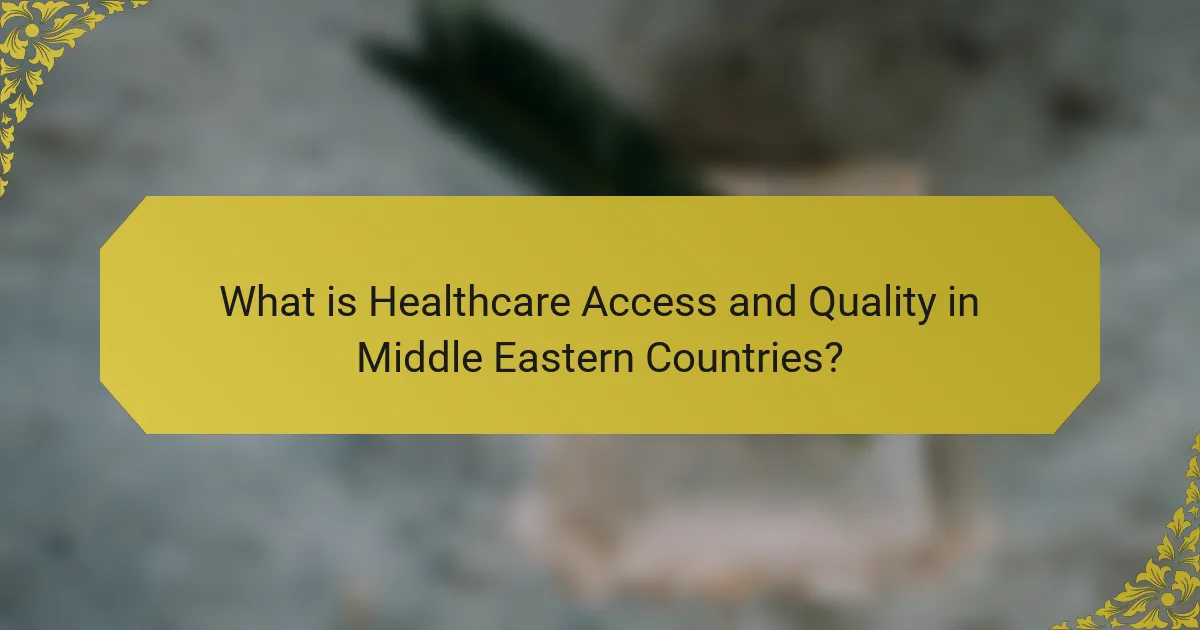
What is Healthcare Access and Quality in Middle Eastern Countries?
Healthcare access and quality in Middle Eastern countries refer to the availability and standard of medical services provided to populations in this region. Access involves the ease with which individuals can obtain necessary healthcare services. Quality pertains to the effectiveness and safety of the care delivered. Many Middle Eastern countries have made significant investments in healthcare infrastructure. For example, countries like the United Arab Emirates and Qatar have advanced healthcare systems. However, disparities exist in access and quality across different regions and demographics. Rural areas often face challenges in accessing healthcare compared to urban centers. Additionally, factors such as socioeconomic status and education influence healthcare access. According to the World Health Organization, healthcare quality varies widely, with some countries achieving high standards while others struggle with basic service provision.
How is healthcare access defined in the context of Middle Eastern countries?
Healthcare access in Middle Eastern countries is defined as the ability of individuals to obtain necessary medical services. This access is influenced by factors such as economic status, geographic location, and healthcare infrastructure. In many Middle Eastern nations, disparities exist between urban and rural areas. Urban populations often have better access to healthcare facilities and services. Conversely, rural areas may face challenges such as fewer healthcare providers and longer distances to facilities. Additionally, socioeconomic factors play a significant role in determining access. Wealthier individuals typically experience better access compared to those from lower-income backgrounds. Furthermore, government policies and healthcare systems vary across the region. Some countries provide universal healthcare, while others rely on private systems. These variations impact the overall accessibility of healthcare services.
What are the key indicators of healthcare access in these regions?
Key indicators of healthcare access in Middle Eastern countries include availability of healthcare facilities, affordability of services, and accessibility of health insurance. Availability refers to the number of hospitals and clinics per capita. For example, countries with more healthcare facilities generally provide better access. Affordability involves the cost of medical services relative to income levels. High costs can limit access for low-income populations. Accessibility of health insurance is crucial for ensuring that individuals can receive necessary medical care. Regions with higher rates of insured individuals typically experience better health outcomes. Data from the World Health Organization indicates that these factors significantly influence healthcare access across the region.
How do socioeconomic factors influence healthcare access?
Socioeconomic factors significantly influence healthcare access. Individuals with higher income levels generally have better access to healthcare services. They can afford private health insurance and out-of-pocket expenses. Conversely, low-income individuals often face financial barriers. These barriers include the inability to pay for services and transportation issues. Education also plays a crucial role in healthcare access. Higher education levels often correlate with better health literacy. This enables individuals to navigate the healthcare system more effectively. Additionally, employment status affects access to employer-sponsored health insurance. In many Middle Eastern countries, socioeconomic disparities lead to unequal healthcare distribution. A study by the World Health Organization highlights these disparities in access and outcomes.
What does healthcare quality entail in Middle Eastern countries?
Healthcare quality in Middle Eastern countries entails several key components. These include accessibility, effectiveness, safety, and patient-centeredness. Accessibility refers to the availability of healthcare services to the population. Effectiveness measures how well healthcare services achieve desired health outcomes. Safety focuses on minimizing risks and harm to patients during care. Patient-centeredness emphasizes the importance of respecting and responding to individual patient preferences and needs.
In recent years, many Middle Eastern countries have invested in improving healthcare infrastructure. For example, the World Health Organization reported that countries like Qatar and the UAE have made significant strides in healthcare quality through modernization and investment. Additionally, healthcare accreditation bodies, such as the Joint Commission International, have been engaged to enhance service standards across the region. These efforts are crucial for achieving better health outcomes and ensuring patient satisfaction in Middle Eastern healthcare systems.
What are the primary metrics used to assess healthcare quality?
The primary metrics used to assess healthcare quality include patient outcomes, patient safety, and patient satisfaction. Patient outcomes measure the effectiveness of care, such as recovery rates and mortality rates. Patient safety focuses on the prevention of errors and adverse effects during healthcare delivery. Patient satisfaction gauges the experiences and perceptions of patients regarding their care. Other important metrics include adherence to clinical guidelines and the efficiency of care delivery. These metrics are widely recognized in healthcare quality assessments and are used by organizations like the World Health Organization.
How do patient outcomes reflect the quality of healthcare services?
Patient outcomes are a direct indicator of the quality of healthcare services. High-quality healthcare services lead to better patient outcomes, such as reduced mortality rates and improved recovery times. For instance, studies show that hospitals with higher nurse-to-patient ratios have better patient outcomes. Additionally, effective communication between healthcare providers and patients enhances treatment adherence, resulting in favorable outcomes. Data indicates that patient satisfaction scores correlate with lower readmission rates. Therefore, consistent monitoring of patient outcomes can identify areas for improvement in healthcare quality.
What are the major challenges to healthcare access in Middle Eastern countries?
Major challenges to healthcare access in Middle Eastern countries include inadequate infrastructure and limited healthcare funding. Many regions suffer from a lack of hospitals and clinics. This shortage leads to long travel distances for patients seeking care. Additionally, healthcare systems often face staffing shortages. There is a high demand for qualified medical professionals. Political instability in some countries further complicates healthcare delivery. Conflict can damage healthcare facilities and disrupt services. Economic disparities also play a significant role. Wealth inequality affects access to quality care. Furthermore, cultural barriers can hinder the utilization of available healthcare services. These challenges collectively impact the overall health outcomes in the region.
How do political and economic instability affect healthcare access?
Political and economic instability significantly hinders healthcare access. Instability can lead to inadequate funding for healthcare services. For instance, countries experiencing conflict often divert resources from health to military needs. This results in a shortage of medical supplies and personnel. Economic downturns can also increase unemployment, limiting individuals’ ability to afford healthcare. A study by the World Bank found that in conflict-affected areas, healthcare facilities often close or operate at reduced capacity. Furthermore, political unrest can disrupt transportation networks, impeding access to medical facilities. In summary, instability directly correlates with reduced healthcare availability and quality.
What role does infrastructure play in healthcare accessibility?
Infrastructure is crucial for healthcare accessibility. It includes physical facilities, transportation systems, and communication networks. Effective infrastructure ensures that healthcare services are available and reachable. For instance, well-constructed hospitals and clinics provide essential services. Reliable transportation allows patients to reach these facilities quickly. Additionally, communication infrastructure enables telemedicine, expanding access to healthcare. Studies show that regions with better infrastructure report higher healthcare utilization rates. For example, a report by the World Health Organization highlights the correlation between infrastructure quality and health outcomes. In summary, robust infrastructure directly influences healthcare accessibility and quality in Middle Eastern countries.
How does healthcare quality vary across different Middle Eastern countries?
Healthcare quality varies significantly across different Middle Eastern countries. Countries like Israel and the UAE have advanced healthcare systems with high standards. Israel ranks highly in healthcare outcomes, with a life expectancy of 83 years. The UAE has invested heavily in healthcare infrastructure, leading to improved access and quality.
In contrast, countries such as Yemen and Syria face severe challenges. Yemen’s healthcare system has been devastated by conflict, resulting in poor health outcomes. Syria’s ongoing war has led to a collapse of healthcare services, impacting quality drastically.
Overall, variations in healthcare quality stem from factors like economic resources, political stability, and investment in healthcare infrastructure.
What are the differences in healthcare systems among these countries?
Healthcare systems among Middle Eastern countries vary significantly. Countries like Saudi Arabia and the UAE have government-funded healthcare systems. These systems provide free or subsidized healthcare to citizens. In contrast, countries like Lebanon rely more on private healthcare providers. This leads to higher out-of-pocket expenses for patients. Additionally, health insurance coverage is less comprehensive in some regions. For instance, Iraq’s healthcare system faces challenges due to political instability. This affects access to care and quality of services. Overall, disparities exist in funding, access, and quality across these nations.
How do cultural factors impact the perception of healthcare quality?
Cultural factors significantly influence the perception of healthcare quality. These factors include beliefs, values, and social norms prevalent in a community. For instance, traditional beliefs may lead individuals to prioritize certain treatments over others. Language barriers can also affect communication between patients and healthcare providers. In Middle Eastern countries, cultural attitudes towards gender roles may impact women’s access to healthcare services. Studies show that cultural competence among healthcare professionals enhances patient satisfaction. According to a report by the World Health Organization, culturally sensitive care improves health outcomes and patient trust. Overall, cultural factors shape expectations and experiences within healthcare systems.
What initiatives are being implemented to improve healthcare access and quality?
Governments in Middle Eastern countries are implementing various initiatives to enhance healthcare access and quality. These initiatives include expanding telemedicine services to reach remote populations. Countries are investing in healthcare infrastructure to build more hospitals and clinics. Training programs for healthcare professionals are being prioritized to improve service delivery. Public health campaigns are promoting preventive care and health education. Partnerships with international organizations are facilitating knowledge transfer and best practices. Financial assistance programs are being introduced to make healthcare more affordable. Technology integration in health systems is enhancing patient data management and care coordination. These efforts aim to address disparities and improve overall health outcomes in the region.
How are governments addressing healthcare disparities?
Governments are addressing healthcare disparities through targeted policies and programs. They implement universal healthcare systems to ensure access for all citizens. Many governments are increasing funding for underserved regions. They also focus on training healthcare professionals in these areas. Public health campaigns raise awareness about available services. Additionally, partnerships with NGOs enhance healthcare delivery. Data collection helps identify gaps in service. These measures aim to improve health outcomes for marginalized populations.
What role do international organizations play in enhancing healthcare systems?
International organizations play a crucial role in enhancing healthcare systems. They provide funding and resources to improve infrastructure and services. Organizations like the World Health Organization (WHO) set guidelines for health practices. They also facilitate training programs for healthcare professionals. International organizations promote research and data collection on health issues. They assist in emergency response during health crises. Their collaboration with local governments strengthens healthcare policies. This support leads to improved health outcomes in communities.
What best practices can be adopted to enhance healthcare access and quality?
Adopting best practices like telemedicine, community health programs, and health education can enhance healthcare access and quality. Telemedicine allows patients to consult with healthcare providers remotely, reducing travel barriers. Community health programs can address specific local needs and improve outreach to underserved populations. Health education initiatives empower individuals to make informed health choices. Data from the World Health Organization indicates that these strategies can significantly improve health outcomes. Countries implementing such practices have reported increased patient satisfaction and better health metrics.
How can technology improve healthcare delivery in the Middle East?
Technology can significantly improve healthcare delivery in the Middle East by enhancing access, efficiency, and quality of care. Telemedicine allows patients in remote areas to consult healthcare professionals without traveling long distances. Electronic health records streamline patient information sharing among providers, reducing errors and improving treatment coordination. Mobile health applications facilitate health monitoring and education, empowering patients to manage their conditions. Data analytics can identify health trends and resource allocation needs, leading to better public health strategies. The integration of artificial intelligence aids in diagnostics and personalized treatment plans. In 2020, a study found that telehealth services increased patient engagement by 30% in the region. These advancements collectively contribute to a more effective healthcare system in the Middle East.
What community-based strategies are effective in increasing healthcare access?
Community-based strategies that effectively increase healthcare access include mobile health clinics, community health workers, and health education programs. Mobile health clinics provide essential services in underserved areas. They reduce transportation barriers and reach populations with limited access to traditional healthcare facilities. Community health workers serve as liaisons between healthcare providers and communities. They promote health education and assist individuals in navigating healthcare systems. Health education programs raise awareness about available services and preventive care. These programs empower individuals to seek care proactively. Research indicates that such strategies improve health outcomes and increase service utilization in low-access areas. For instance, a study published in the “International Journal for Equity in Health” highlights the positive impact of community health workers in enhancing healthcare access in rural regions.
Healthcare access and quality in Middle Eastern countries encompass the availability and standard of medical services for diverse populations in the region. This article examines the factors influencing healthcare access, such as socioeconomic status, geographic location, and government policies, highlighting disparities between urban and rural areas. It also explores key indicators of healthcare quality, including patient outcomes, safety, and satisfaction, while addressing challenges like inadequate infrastructure and political instability. Additionally, the article discusses initiatives and best practices aimed at improving healthcare access and quality across these nations.


